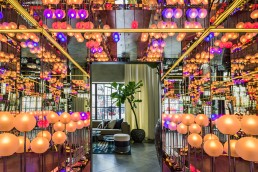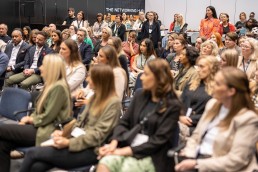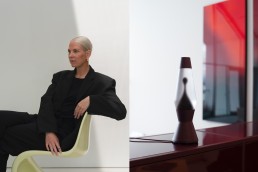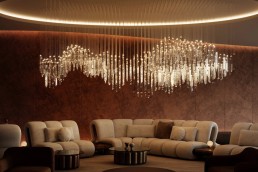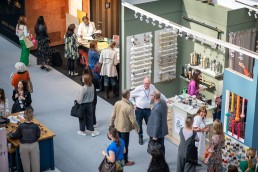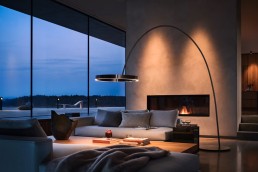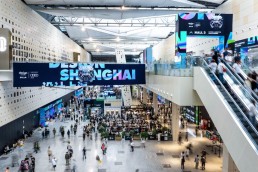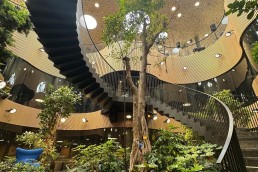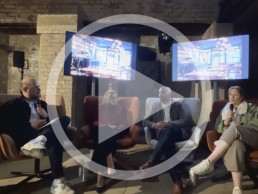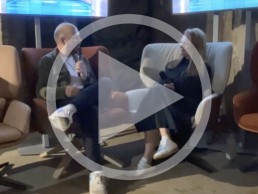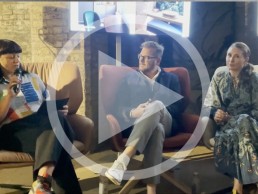Sanjit Bahra: ‘Elevating Your Brand Through Strategic Design'
 In May, darc hosted a number of panel discussions at the Light exhibition during Clerkenwell Design Week. One of the panel talks explored ‘Elevating Your Brand Through Strategic Design’, with panelists Mara Miller, Founder of Industville, Sanjit Bahra, Founder of Design Plus Light, and Inge Watrobski, Head of Design at Heartwood Collection Light.
In May, darc hosted a number of panel discussions at the Light exhibition during Clerkenwell Design Week. One of the panel talks explored ‘Elevating Your Brand Through Strategic Design’, with panelists Mara Miller, Founder of Industville, Sanjit Bahra, Founder of Design Plus Light, and Inge Watrobski, Head of Design at Heartwood Collection Light.
Bahra later expanded on the topic, sharing his thoughts from a lighting designer’s perspective. See his findings below.
When we walk into a space, all of our senses are activated, and we make judgements using our senses. With human beings, 60% of the neocortex (perception part of the brain) is used for processing visual stimuli (sight), the next dominant sense is hearing, which accounts for around 13%. This is how heavily we are weighted by what we see and that is influenced on how light falls on a space and the quality of the light.
Therefore, if a hospitality space is not well-lit, and a client is disappointed when entering that space, you’ve instantly lost connection and traction with the brand. And that can equate to money – how successful the space operates.
Fabrics and finishes can be changed or modified fairly easily but changing the lighting (once a project is completed) can involve a considerable financial investment to improve or upgrade. That’s why it’s better, and cheaper, to get it right the first time.
The hospitality customer base can be fickle, and competition is tough - so, underwhelmed clients will simply move on. If it doesn’t feel memorable or photograph well, people will seek out another well-lit place that they feel more comfortable in.
Humans are emotional creatures; we feel first and think second. When we enter a space our senses (sight, sound, smell, temperature, etc.) produce an emotional response and then our brains process these into thoughts and judgements such as good, bad, exciting, cool and so on. As we are such visual creatures, lighting design has the power to influence how we perceive and connect with a space. One moment it can make us feel energised and activated. At the touch of a button the same space can be presented in a completely different way – making us feel more relaxed and at ease.
I believe in great lighting design, for the interior environment, should be a ‘tertiary experience’. When we walk into a well-lit and well-designed environment, we normally feel positive and engaged with that space. Our brains then kick in to determine why we feel this way and so the eye goes to the beautiful finishes, furniture or architecture. It’s only after a while the customer realises that there is something quite wonderful about the “ambience” or the “mood” – that’s great lighting design, a subtle journey of emotion.
There are only two times when lighting is a ‘primary experience’. The first is when there is a fabulous feature, fitting, and installation. Something fantastic to catch your eye. And the second is when it is a mistake. Poor lighting design will always detract from beautiful architecture and interior design. It’s such a shame when a fabulous interior, architectural façade or garden is ruined by bad lighting at night. Poorly thought-out or installed lighting will cost you.
We are also entering a time where, I believe, there needs to be less visual clutter in a space. We are so overly stimulated on a far too frequent basis. There is more lighting and visual stimulus in our lives than ever before; from screens to displays and the plethora of lighting effects one can create. When it comes to the business of lighting design, less is more – we do not need as much light as tradition has held onto. All lighting needs to be carefully considered to create the desired effect, but without overwhelming people. Shadow is often a forgotten (and necessary) tool in creating form, space and respite.
As humans, we are also drawn to stories. All the successful brands sell more than just their product. They sell a story or idea – which translates to a feeling. That’s where lighting design also comes in. The first thing we ask is, “what is the narrative that needs to be told in each case?” And then we ask ourselves “How do we achieve this through lighting”. The answers that come out of the iterative process of asking these questions at the very beginning of a project, informs and guides us on the foundations of each design we do for our clients.
The added pressure to designing for hospitality is having to ensure a space is social media friendly. Gone are the days when a professional photographer would take a few carefully curated photos that would control how a space is viewed by the world in a few aspirational magazines. Now every public space is papped on a phone – exposing everything for all and sundry to see practically from day one.
Lighting is the perfect tool to create vignettes that are shareable and content-worthy. Instagram is a great platform for showcasing the role that lighting plays. It immediately shows how different spaces can look throughout the day and night. Instagram is also an important marketing tool in that respect.
A fantastic example is at the Mondrian Shoreditch hotel in London, where DesignPlusLight designed the lighting. The luggage room was converted into a mirror clad feature with colour changing glass balls. The colour change effects, and the reflections make for an amazing photo, which people love to snap and share with their friends or on social media. But every time you go it’s a different scene and lighting experience, creating that pull to go back time and time again, or for others to go and see it for themselves. It was also cleverly contained within a small space – making it feel like an installation and the lighting effects did not spill over into the rest of the hotel. Four years on and it is still creating a buzz and makes people feel engaged and excited with the brand.
Equally this ‘for the moment’ approach to lighting also needs to be balanced with the need to create timeless designs that don’t instantly age or quickly become out of vogue. A key area for this is sustainability, and it is important that this is built into a scheme for the right reasons, not just to greenwash a space or a project. Compounding this, younger generations are understandably concerned about the environment, and will always favour those companies and brands that truly care about sustainability.
Brand loyalty is hard to gain, and even harder to keep if you’re not creating the right environment. Hospitality venues have to activate people’s senses more than ever before, and lighting is one of the main priorities to get right in order to be successful.
www.designpluslight.com
darc’s key take aways from Bahra’s comments:
- Human Emotions and Decision-Making: Understanding human emotions is crucial for creating successful hospitality brands. Humans react emotionally first; lighting design can significantly influence these reactions.
- Senses and Perception: 60% of the neocortex is dedicated to visual processing; sight heavily influences our judgments, followed by hearing (13%).
- Importance of Lighting: Poor lighting can instantly disconnect a client from the brand, impacting the success of the space.
- Cost of Lighting Adjustments: Changing lighting post-project completion is expensive; it's better to get it right first time.
- Customer Expectations: Hospitality customers are fickle; a well-lit, memorable space is essential to retain them.
- Tertiary Experience: Good lighting design should subtly enhance the ambiance and mood, making the space feel positive and engaging.
- Primary Experience: Lighting is primarily noticed if it is exceptionally good or bad; poor lighting can ruin otherwise beautiful interiors and architecture.
- Less is more: excessive lighting and visual stimuli should be avoided. Shadow is an essential tool for creating form and space.
- Narrative and Storytelling: Successful brands sell a story or idea, and lighting design should support this narrative.
- Social Media Influence: Spaces must be social media friendly as they are frequently photographed and shared online.
- Timeless Design and Sustainability: Lighting designs should be timeless and sustainable, aligning with environmental concerns of younger generations.
- Brand Loyalty: Creating the right environment through effective lighting design is essential for gaining and maintaining brand loyalty in hospitality venues.
To find out more about this topic go to darcTV at www.darcmagazine/darctv to watch the full panel discussion at Clerkenwell Design Week 2024.
Women in Lighting Network at Manchester Furniture Show
Last Thursday the darc team made a trip into Manchester for the Manchester Furniture to support the Women in Furniture Networking Brunch.
The Women in Furniture Network (WFN) is a group founded by the team behind the Furniture Shows (Top Drawer, Scotland's Trade Show, Home & Lifestyle Show, Janurary Furniture Show, Manchester Furniture Show, Home & Gift, Reveal), aimed at supporting women in the furniture industry through events, networking, mentorship opportunities and more. It gives women a platform and network to share their perspectives and learn and connect with other like-minded women in the industry.
The event consisted of refreshments and a special keynote speaker, Melinda Whittington, President and CEO of La-Z Boy, Furniture sharing her insights on her varied career from economics into design, and eventually climbing the ladder in the furniture industry.
www.linkedin.com/womeninfurniture
Mathmos announces second collaboration with Sabine Marcelis
(UK)- Inventor of the world’s first lava lamp, Mathmos, has announced a second collaboration with multi-disciplinary designer Sabrine Marcelis.
Following the success of its first collaboration in 2023 the collaborators released the Astro Lava Lamp, created specifically for Dutch artist’s VitaHaus Loft installation in Weil am Rhein in June 2024.
Its design is created to blend within the burgundy colours used in Marcelis’ bedroom design for the VitraHaus Loft installation. A metal base and cap are cast from hand-spun aluminium and painted in matt Bordeaux red shade along with a burgundy braided cord and black inline switch and plug. Its glass bottle is hand-finished with a frosted coating creating a soft light to the custom burgundy lava. Marcelis says: “I am a big fan of Mathmos’ iconic lava lamps and had so much fun working on our first collaborative design. It felt natural to include an Astro lava lamp in the bedroom at the VitraHaus Loft, and I'm glad we were able to introduce a new limited edition lava lamp to match the colour scheme for the occasion!”
Cressida Granger, Mathmos, says: “It is a great honour to work with Sabine again after the success of her first collaborative lamp, which sold out within hours last year. I’m sure her new design will be equally popular.”1000 pieces will be available internationally from October 2024. Each lamp will be uniquely marked with its limited-edition number on the base, and delivered in a bespoke Sabine Marcelis-designed burgundy box.
Cameron Design House - Baltic series
(UK) – British lighting and furniture studio launches the Baltic lighting series with inaugural piece, Vetta.
Drawing inspiration from the landscapes of Finland, the series explores the elements water, snow, wind and ice. Created under the guidance of Creative Director and Founder Ian Cameron, Vetta, meaning water in Finnish, encapsulates the namesake element.
Ian Cameron, Founder of Cameron Design House, says: "My designs have always been intertwined with nature and the new Baltic series is no exception to this. Heavily influenced by my Finnish heritage, the series explores the natural elements of its landscape - water, wind, fire, and earth. I am excited to unveil Vetta, the first piece in the series, inspired by water with more mesmerising pieces to follow. Each piece in the Baltic Series will honour the essence of my Finnish roots."
Decorex announces 47th edition
(UK) – Decorex returns to Olympia events in London on 6-9 October.
Featuring over 280 brands showcasing furniture, lighting, fabrics and more. Attendees can explore the latest trends, product launches and attend a comprehensive talks programme with over 85 industry experts as speakers.
Sustainability will be a core focus, with initiatives like Better Stand’s project, which aims to reduce waste caused by stands and exhibitions by implementing reusable structures. Also, the show will be powered by 100% renewable electricity, preventing of an estimated 21.5 tons of CO2. To reinforce sustainability values within the design industry, Decorex is continuing to work with the Sustainability Task Force who together are introducing the Decorex Sustainability Awards, judging categories such as ‘Innovative Design’ and ‘Driving Force for Change’.
Renowned design studio Brady Williams will design the central bar, while The New Craftsmen, an organisation which commissions and sells unique contemporary objects will create unique entrance features.
Registration is now open, early bird tickets are available until/from 12 July.
Occhio - Edizione Lusso Lamp
(Germany) – German lighting company has released a nature inspired luminaire using natural materials and colours.
Edizione Lusso is a new edition to Occhio’s Mito series, the signature collection designed by the brand’s founder, Axel Meise. The lamp is now available in various marble finishes while keeping Occhio’s high-tech performance.
Edizione Lusso now comes in three colourway options for the marble base of the luminaire: Vivo, Scuro, and Caldo. Vivo combines green marble with Ascot leather in the colour "Grigio" along with iridescent surface finish "Phantom”. Scuro offers a darker finish, using Nero Marquina marble with Ascot leather in the colour "Nero" and the surface "Black Phantom". While Caldo uses Marrone Emperador marble, Ascot leather in the colour "Marrone" and the "Phantom" surface.
www.occhio.com
Design Shanghai celebrates 11th edition
(China) – Asia’s largest international Design Festival welcomed 80,000 visitors to the Shanghai World Expo Exhibition and Convention centre on 19-22 June.
Over three days the event hosted 600 brands from 40 countries, showcasing a blend of Eastern and Western design philosophies. With the addition of a new hall, the fair included forums and workshops with prominent designers discussing trends such as sustainable design and traditional craftmanship.
The show celebrated Chinese design talent and international participation was notable in sectors like lighting, furniture, and accessories. The design talks programme facilitated discussions on future design trends and welcomed speakers such as Aldo Bakker founder of Aldo Bakker Studios and Thomas Heatherwick founder of Heatherwick Studio. Audi, a long-time partner of the show, showcased its advancements in auto motive lighting technology by presenting an interactive installation named ‘Language of Light’.
Zhuo Tan, Director of Design Shanghai, says; "2024 has been a challenging year for designers, architects, brands, and everyone in the design industry. Design Shanghai has always embraced change and faced challenges head-on. This year, the show was buzzy and dynamic, resembling an annual grand gathering for designers, with many discovering new directions for the future. This is exactly our aim - to instil confidence in the design industry and give designers a much-needed boost.”
New additions and highlight for 2024 included:
- Talents, curated by designer Frank Chou, aimed to inspire young emerging designers, who were invited to explore the theme "The Quest For The Question".
- Chen Min curated neooold, which featured the theme “Art Extension, which converges crafts with the origins of modern art.
- Craft+ presented an exploration of China's heritage and traditional craftsmanship, highlighting textile techniques of ethnic minorities, with a focus on revitalising traditional crafts through design collaborations.
- "Rong Casting" Exhibition: Returning for its ninth edition the exhibit commits to deconstructing traditional handicrafts into materials and techniques.
Design Shanghai will return for its 12th edition in 2025 as well as launching a brand-new show on 31 October 2024, Design Shanghai Collectible.
Maria Cheung on 3 Days of Design
Maria Cheung is Director and Head of Interior Design at award-winning architecture and design practice Squire & Partners. Cheung’s experience spans workspace, residential and hotel developments and extends to bespoke installations and products, retail d isplays and exhibition design. She is regularly invited to judge WIN, Dezeen and FX award programmes and speak at industry events including Workspace Design Show, London Design Festival and London Craft Week. Design is a passion for Maria, who strives to create beautiful spaces that transcend their functional requirements to surprise and enhance the user’s experience.
isplays and exhibition design. She is regularly invited to judge WIN, Dezeen and FX award programmes and speak at industry events including Workspace Design Show, London Design Festival and London Craft Week. Design is a passion for Maria, who strives to create beautiful spaces that transcend their functional requirements to surprise and enhance the user’s experience.
This month Cheung attended 3 Days of Design, which ran 12 – 14 June, in Copenhagen, Denmark. The event saw numerous brands showcasing new products in various showrooms and design destinations throughout the city, attracting a buzz of industry experts, press, and public visitors. darc invited Cheung to share her experiences at the event, and present some of her top lighting pics. Check them out below.
It was my first time attending the event - as soon as I arrived there was a great atmosphere of celebration and sharing. Copenhagen was alive and buzzing with designers, suppliers and dealers. There were visitors from all over the world, including a particularly large contingent from the UK – specifically the London design community. Familiar faces popped up at different events and showrooms and there were plenty of opportunities to make new connections.
For many brands, it was an opportunity for their international representatives to meet and bond. Suppliers at each showroom proudly displayed their products in new arrangements and were very generously feeding and watering all who came through their doors! Colourful branded tote bags filled the streets and served as reminders for places yet to visit. Parties ran through the night and energy remained high during the three days, which were fuelled by coffee and excitement.
It was interesting to see so many brands in their own showroom setting where their identity is inherent and can really be showcased. I saw lots of beautiful installations that had been prepared especially for the event, which displayed new products as well as existing ones, and which allowed for many people to flow through. Clearly this is more sustainable than building bespoke sets in a large exhibition hall, as the time and investment creating new arrangements within showrooms goes beyond the three-day festival, and therefore offers more longevity.
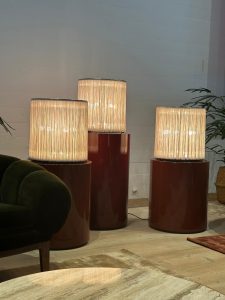
Some brands such as Federica, Audo, &Tradition already have beautiful hospitality settings which weave lifestyle and products together seamlessly within their showrooms. Others chose to exhibit their ranges in iconic spaces within the city. One example of this was Fritz Hansen at the Opera Parken, where little material intervention was required to expertly display their indoor and outdoor furniture sets. For brands who don’t have large showrooms in the city, group exhibition. were set within stunning architecture and interiors such as the Odd Fellow Palæet.
It was a fantastic way to experience multiple brands while exploring Copenhagen. Showrooms were spread across walkable distances or a scenic boat ride from the historic city centre to the regenerated coastal industrial area of Nordhaven.
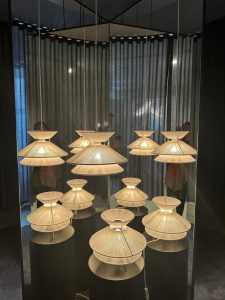
We were treated to meeting new lighting designer Sissel Gram Warringa, who launched ‘Peel’ for Frandsen – a family of wall, pendant and table lamps, which use a single sheet of curved stainless steel to cleverly provide shade, base and wall fixing. She presented her research around material selection, explaining how stainless steel affects the quality of light and the importance of mock-ups and trials in ensuring a correct design. It’s always inspiring to meet designers and see the huge effort and passion they pour into their craft. Within the same exhibition by Frandsen, simple yet innovative use of mirrors enhanced the experience of the beautiful ranges – from large circular mirrors that reflect the base of suspended lights to an array of angled mirrors which create the illusion of infinite light fittings.
Having never attended before I cannot comment on how the presence of lighting has changed over the event 10-year run. However, it is very clear that lighting is an integral part of the festival. Aside from the established lighting companies who have their own dedicated showrooms – such as Louis Poulsen at Frederiksholm – furniture brands like Gubi and Verpan also have their own characterful pendants, wall, floor and table lights which are designed to live harmoniously with their other curated furniture ranges.
Elevating Your Brand and Business Through Strategic Commercial Interior & Lighting Design at CDW
https://vimeo.com/953979153?share=copy
Our panel of design experts: Mara Miller, Industville; Sanjit Bahra, Design Plus; Inge Watrobski, Head of Design, Heartwood Collection Light, discusses how strategic commercial interior and lighting design can elevate a brand’s identity, customer loyalty, and in turn build business opportunities.
The future of hospitality design with Holly Hallam of DesignLSM at CDW
https://vimeo.com/953948988?share=copy
Interior designer Holly Hallam discusses what the future of hospitality design could look like; what will impact design choices; and how designers might need to adapt.
Discussion on 'Lighting and Wellness' with Jo Littlefair at CDW
https://vimeo.com/953983964?share=copy
Jo Littlefair of interior design studio Goddard Littlefair discusses the use of lighting when working on wellness interior design projects, referencing the studio’s work on the spa at Raffles London at The OWO.
In Conversation with... interior designers Staffan & Monique Tollgard at CDW
https://vimeo.com/954343703?share=copy
[d]arc media’s managing editor, Helen Ankers sits down with the design duo reflecting on their 20-year career history, how the industry has changed for designers in general, as well as what has changed for products and trends in lighting.

